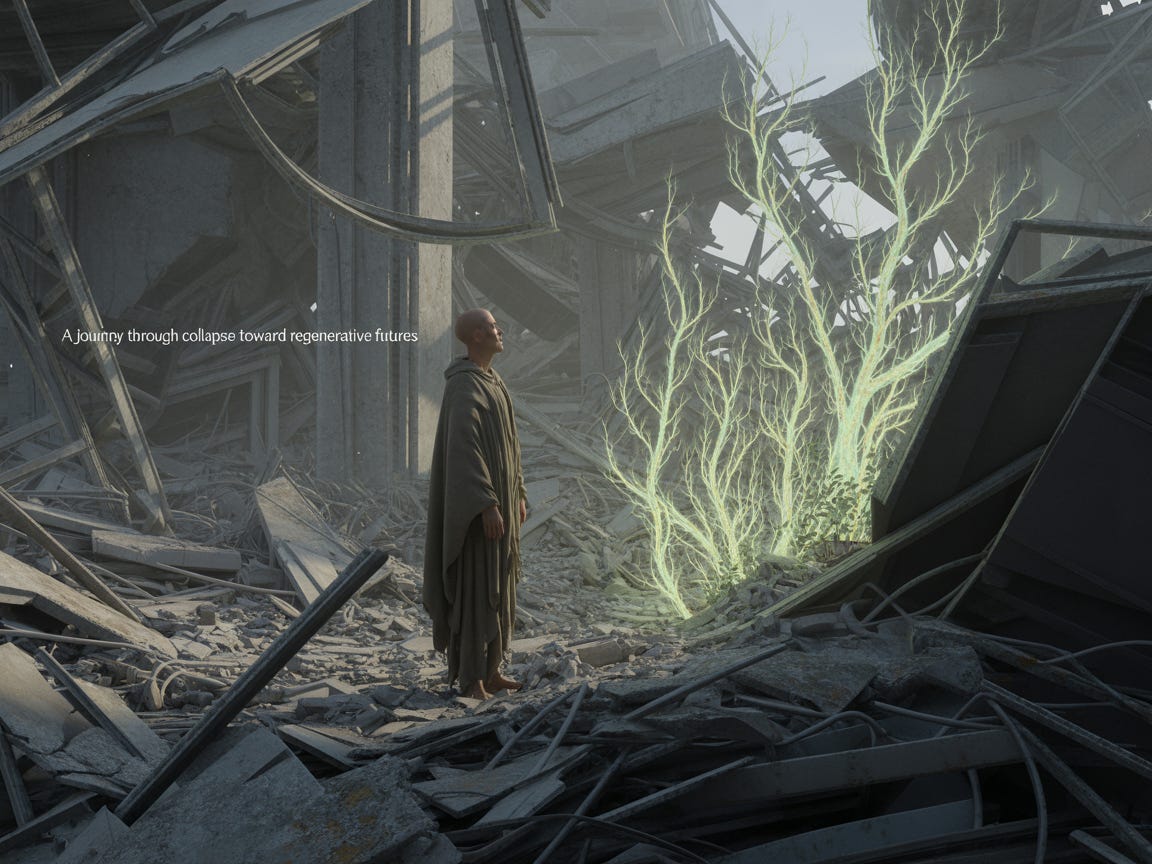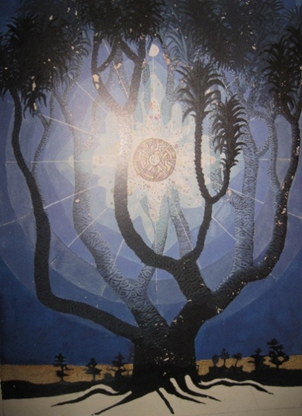"These approaches fail because they refuse to confront the core issue: the lifestyle and infrastructure of modern industrial civilization are fundamentally incompatible with the biophysical realities of our planet. True sustainability would require radical reductions in energy and material throughput, dramatic decreases in consumption levels, and a fundamental restructuring of economic and social systems—changes so profound that they would amount to the "end" of civilization as we know it. "
https://richarddavidhames.substack.com/p/beyond-the-event-horizon
I was deeply moved when I encountered this article on Substack by philosopher and futurist Richard David Hames. He so eloquently and succinctly says it as it is, now. Where do we go from here? We are living, I believe and agree with the author, in the chaos of end stage capitalism, cultural collapse, and in the U.S., governmental collapse, all set against the global environmental catastrophe of climate change.
People like me, and scientists, mythologists, writers, artists, politicians and many others, have been talking about "paradigm change" and "re-mything culture" for a long time. Here we are, and where do we go from here? How can we "compost" the "detritus of our failing civilization into the foundations" of what is to come? How do we navigate in a collapsing system, and also such profound cultural denial? I take the liberty of sharing this important article here, as this Author speaks I believe so well to what is occuring. I highly recommend to any who read this post subscribing to Mr. Hames Substack Blog. He is one of those who are "Realists of a larger Reality".
"Our task is not to prevent collapse, we've already past the point of no return. Our task is to compost the detritus of our failing civilization into the foundations for whatever emerges from this vast transformation. This requires grieving the loss of the familiar world while remaining open to possibilities that we cannot yet imagine. It means cultivating resilience and adaptability rather than efficiency and growth. It demands that we rediscover our embeddedness within the living systems that sustain all life, abandoning the mythology of separation that has brought us to this threshold."
The symptoms manifest across every domain of planetary function: carbon cycles destabilised by the combustion of ancient organic matter, nitrogen cycles overwhelmed by industrial fertiliser production, hydrological systems disrupted by massive infrastructure projects, and biodiversity hemorrhaging through habitat destruction and chemical contamination. These are not separate crises, they are interconnected expressions of a fundamental mismatch between the operational logic of industrial civilisation and the biophysical constraints that govern all life on this planet.
Our species has consumed the geological inheritance of millennia in mere centuries, burning through fossil fuels accumulated over hundreds of millions of years, strip-mining the planet's mineral wealth, and harvesting renewable resources—forests, fisheries, fertile soils—at rates that surpasses nature's ability to replenish them. Meanwhile, we have overwhelmed the biosphere's waste-processing capacity, saturating the atmosphere with carbon dioxide, choking the oceans with plastic, and poisoning ecosystems with an ever-expanding cocktail of synthetic chemicals that natural systems cannot break down or incorporate.
To understand how we arrived at this juncture, we must trace the arc of human development from our earliest emergence as a species. Our ancestors evolved with biological imperatives perfectly suited to their environment: survive, reproduce, consume available resources, and expand into new territories when possible. These instincts served us well in a world where human populations were tiny and technical capabilities limited. But our capacity for innovation—the discovery of fire, the development of tools, the evolution of intricate social cooperation—began to allow us to transcend natural constraints in ways that would ultimately prove catastrophic.
The agricultural revolution marked a pivotal turning point, transforming human societies from nomadic hunter-gatherers into settled civilizations capable of generating food surpluses. This abundance enabled population growth, social stratification, and the concentration of power in urban centres. More notably, it fundamentally altered our relationship with the natural world, shifting from participation within ecological systems to domination over them. Growth became not merely an opportunity but an imperative, both for survival in competitive environments and as a marker of civilizational success.
The industrial revolution accelerated these trends exponentially, as the discovery and exploitation of fossil fuels provided access to energy stores that had been accumulating in Earth's crust for eons. Coal, oil, and natural gas became the foundation for unprecedented population growth, processes of production, and material consumption, enabling a way of life that seemed to transcend all previous limitations. This fossil-fuelled bonanza created the illusion that perpetual growth was not only possible but natural, obscuring the fundamental reality that we were drawing down finite stores of ancient sunlight at rates millions of times faster than they had been created.
The drivers of our current predicament operate at multiple levels, from the biological to the cultural to the systemic. At the most fundamental level, we remain governed by evolutionary programming that compels us to consume and reproduce without regard for long-term consequences. Our brains evolved to respond to immediate threats and opportunities, not to process abstract dangers that unfold over decades or centuries. In competitive environments, those who exploit resources most aggressively tend to outcompete those who exercise restraint, creating a relentless "race to the bottom" that plays out between individuals, corporations, and nations.
It's worth noting here that while evolutionary drives and competitive systems incentivise short-term exploitation, indigenous wisdom demonstrates that culturally evolved practices—like stewardship, restraint, and cyclical thinking—can realign human behaviour with long-term sustainability, offering pathways to overcome our more self-destructive programming.
Nevertheless, that does not change our present predicament. We have constructed elaborate belief systems that not only justify but actively promote behaviours that are driving us toward collapse. The mythology of technological salvation convinces us that innovation will always provide solutions to whatever problems previous innovations have created, even as our track record demonstrates that new technologies typically generate more problems than they solve, often with greater complexity and unintended consequences. Our economic systems in particular are predicated on the assumption of endless growth, requiring constant expansion of production and consumption to maintain stability, despite the mathematical impossibility of infinite growth on a finite planet.
Most fundamentally, the worldview of human supremacy that underlies modern civilisation portrays our species as separate from and superior to the natural world, justifying the treatment of ecosystems as mere resources to be exploited rather than living systems of which we are an interdependent part. This conceptual separation enables us to externalize the costs of our activities, treating the biosphere as both an inexhaustible source of materials and an infinite sink for wastes.
The tragedy of our situation becomes apparent when we examine the responses that have emerged to address these mounting crises. Despite our growing awareness of environmental degradation and social dysfunction, proposed solutions almost invariably focus on technological fixes and economic adjustments that go out of their way to preserve the fundamental structures and assumptions of industrial civilisation.
Green technologies promise to maintain current consumption levels while reducing environmental impact, ignoring the resource requirements and environmental costs of manufacturing and deploying these technologies at scale. Economic reforms propose to decouple growth from resource consumption and environmental degradation, despite the absence of any historical precedent for such decoupling at the scales and timeframes required.
These approaches fail because they refuse to confront the core issue: the lifestyle and infrastructure of modern industrial civilisation are fundamentally incompatible with the biophysical realities of our planet. True sustainability would require radical reductions in energy and material throughput, dramatic decreases in consumption levels, and a fundamental restructuring of economic and social systems—changes so profound that they would amount to the "end" of civilization as we know it. The resistance to such transformations is understandable but ultimately irrelevant, because these changes will occur whether we choose them or not.
We are already witnessing the early stages of this great unraveling. Multiple planetary boundaries have been crossed, triggering feedback loops that are accelerating environmental degradation beyond our ability to control or reverse. Thawing permafrost releases vast quantities of methane and carbon dioxide, amplifying heating trends. Melting ice reduces the planet's ability to reflect solar radiation back to space, further accelerating temperature rise. Deforestation and ecosystem destruction eliminate carbon sinks while increasing atmospheric greenhouse gas concentrations. These processes are now largely autonomous, continuing regardless of human interventions.
The social and political dimensions of collapse are equally evident. Rising inequality and resource scarcity fuel social unrest and political volatility. While national political horseplay descends into sheer spectacle, conventional governance structures are proving inadequate to address challenges that transcend state boundaries and operate on timescales that exceed electoral cycles. Progressive and conservative political movements alike remain trapped within paradigms which incorrectly assume the possibility of maintaining current civilisation through minor modifications, unable to acknowledge the biophysical limits that constrain all human activities.
Unless we stumble upon a suite of technological miracles, the depletion of cheap, easily accessible energy sources ensures that the industrial system cannot sustain itself indefinitely. As the energy return on energy invested for fossil fuel extraction continues to decline, the economic foundation of modern civilization becomes increasingly unstable. Complex supply chains that depend on cheap transportation fuels become vulnerable to disruption. The elaborate financial systems that facilitate global trade require constant growth to service increasing debt burdens, creating instability that cascades through interconnected economic networks.
Collapse is not a future event to be avoided but a present reality to be navigated. Economic instability, resource scarcity, extreme weather events, and social fragmentation are already disrupting the normal functioning of industrial society. The question is not whether collapse will occur but how rapidly it will unfold, what forms it will take in different regions and communities, and what we must do to adapt.
This recognition, while painful, offers the possibility of liberation from the illusions that prevent us from responding appropriately to our circumstances. Accepting that industrial civilisation cannot be sustained allows us to stop investing energy in futile attempts to preserve the unsustainable and instead begin the work of adaptation and transformation. Living with the reality of collapse means slowing down, becoming more present in our immediate environments, and rediscovering beneficial ways of life that operate within ecological limits rather than in opposition to them.
The end of industrial civilisation doesn't necessarily mean the end of human culture or the possibility of flourishing communities. Throughout history, human societies have demonstrated remarkable ingenuity in developing ways of life adjusted to their local conditions and available resources. The knowledge and skills required for such adaptation still exist, though they have been marginalised by the homogenising forces of industrial development.
Our task is not to prevent collapse, we've already past the point of no return. Our task is to compost the detritus of our failing civilization into the foundations for whatever emerges from this vast transformation. This requires grieving the loss of the familiar world while remaining open to possibilities that we cannot yet imagine. It means cultivating resilience and adaptability rather than efficiency and growth. It demands that we rediscover our embeddedness within the living systems that sustain all life, abandoning the mythology of separation that has brought us to this threshold.
The transition ahead will be neither smooth nor equitable, but it is inevitable. Our choice is not whether to undergo this transformation but how consciously to participate in it. By releasing our attachment to the myths and structures of industrial civilisation, we create space for ways of being that honour the limits and gifts of our earthly home. In the ruins of the old world, the seeds of the new are already beginning to germinate. It's an exciting time for those with a pioneering spirit. A time for real hope that we're able to generate a world of peace and prosperity.











.jpg)







